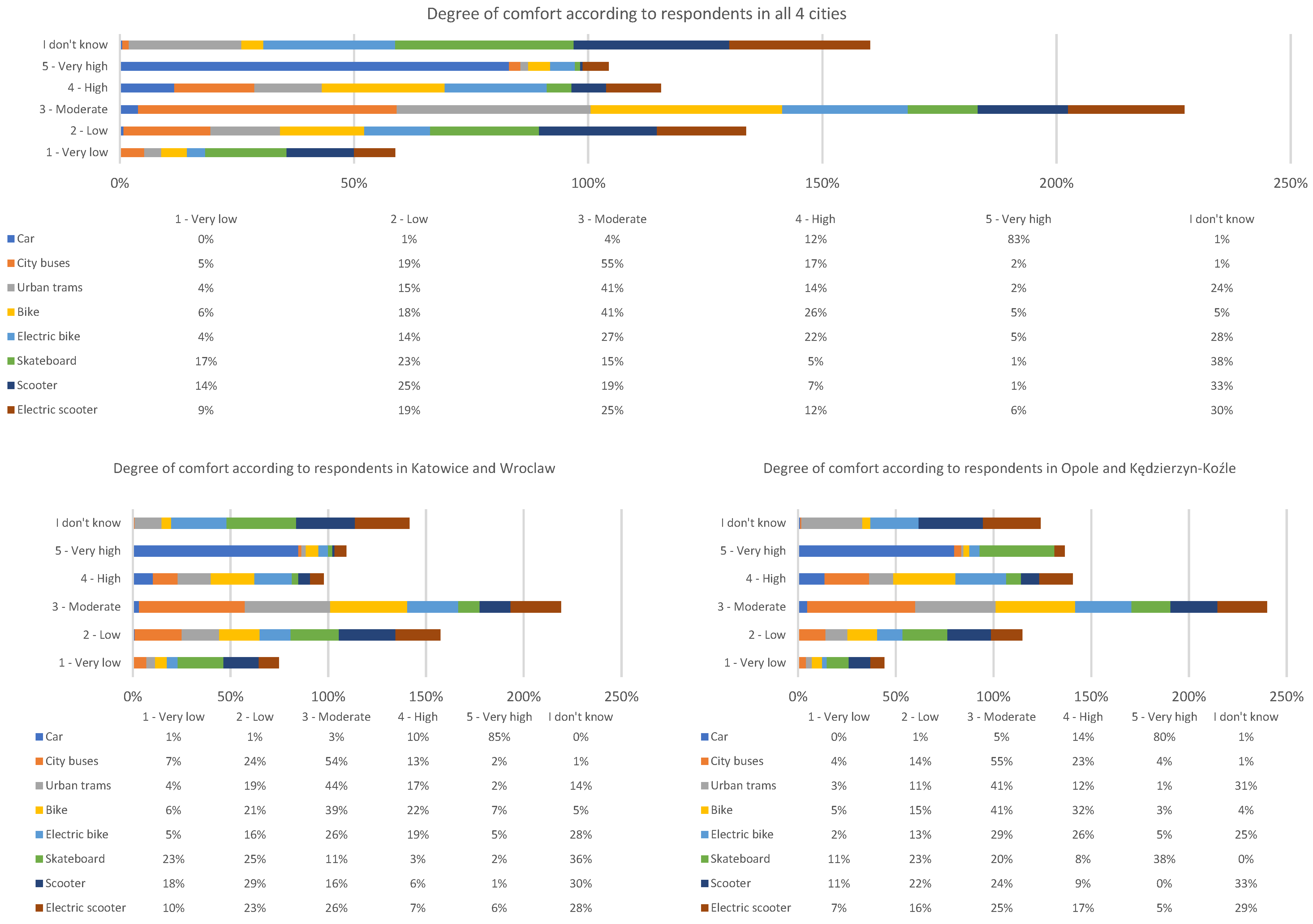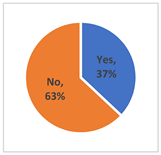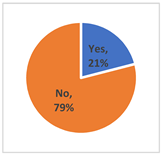4.1. Survey Results on Residents’ Knowledge of Alternative Modes of Transport
This section establishes the frequency and purpose of trips made by the selected means of transport. In addition, alternative modes are compared with other vehicles involved in urban traffic on the basis of safety, comfort, economy, and environmental performance. The frequency of travel by each mode of transport is shown in
Figure 1.
The car is the most popular mode of transport among respondents, as 34% of people use it daily. In the case of public transport, city buses fare much better than trams. It is worth mentioning that the high response rate of “I don’t use” in the case of city trams (22% of answers) is conditioned by the fact that they are not available in Opole and Kedzierzyn-Kozle. Considering the fact that city trams are available in Katowice and Wroclaw, the frequency of travel by such means of transport in those two cities looks quite promising. When it comes to alternative means of transport, the most popular one is the regular bicycle, with as many as 3% of people using this means of transport on a daily basis. Other alternative means of transport are not as popular, with respondents very rarely using an e-bike, skateboard, traditional scooter, or electric scooter. Moreover, on average of 80% do not use the previously mentioned means of transport at all.
Getting to work or school is most often done by car or city bus. Respondents use the car most often to run their personal errands. Respondents use this means of transport most frequently for shopping, which is of course understandable, as in case of big purchases the car is unbeatable in terms of convenience. For reaching social gatherings, respondents most often use city buses, which are slightly superior to motorized two-wheelers. In case of such a travel purpose as recreation, the regular bicycle dominates. Thanks to a bike, a person is able to spend their time engaging in a form of physical activity, relax from everyday problems, and take a breath of fresh air. An unquestionable reason for choosing a bicycle as a means of recreational transport is its versatility, thanks to which it is possible to go to = places that other means of transport do not reach. Other means of transport are similar to the previous question. Few people meet their needs by alternative means of transport. Of the other alternative means of transport, the electric scooter is the second most popular for fulfilling specific destinations. Of all people surveyed, over 75% do not use an electric bike, skateboard, or scooter.
The greatest confidence of respondents In safety was given to the car, with the highest number of “5—Very high” answers (
Figure 2). The second highest rating is given to public transport, where the responses on the city tram side are almost identical to those for city buses. Similar results are characterized by a high degree of safety determined with a rating of 4, between the car and city buses. The safest moderate means of transport was considered by the respondents to be the ordinary bicycle. This may have been influenced by factors such as speed and location or the choice of appropriate personal protective equipment such as helmets. Skateboards, scooters, and electric scooters showed the least confidence in safety, as they were rated the lowest. The key factor working against these vehicles is the absolute lack of any protection in the event of a collision or collision with other means of transport. It is worth mentioning, however, that apart from the car, the city bus, or the bicycle, in the situation with other means of transport, many people gave the answer “don’t know”, thus abstaining from voting. Certainly, many people made this decision because they simply had never experienced such a means of travel.
According to the respondents, the highest degree of comfort can be boasted by the car, which was unrivalled and dominated the poll (
Figure 3). Obtaining 83% of votes with the highest rating for the degree of comfort, i.e., “5—Very High”, is due to a number of factors that the car is characterized by. First of all, the car is a kind of synonym for independence, which manifests itself in many forms. When planning any trip by car, we do not have to set a specific route in advance, keep an eye on the timetable, or check the distances from stops to specific places we want to reach, as in the case of public transport. The advantage of a car over alternative means of transport in terms of comfort can be determined mainly by weather conditions, as a car can be used in all weather conditions. A skateboard or scooter does not provide any protection from rain or snow, provides no roof over the user’s head, and has no predisposition to regulate temperature. These deficits certainly had a huge impact on the respondents’ decision when casting their votes, where alternative means of transport definitely came out the least favorable.
When asked about the degree of economy, alternative modes of transport scored much better than for the degree of comfort (
Figure 4). Respondents ranked the bicycle as the cheapest means of transport. The skateboard and the traditional scooter were ranked next in terms of the most favorable degree of economy. The most negative votes regarding the degree of economy went to the car. These positions may be due to the fact that, in addition to the amount of money to be spent on the purchase of the means of transport, the additional costs include their maintenance. However, the sum of these additional costs will certainly not be great. If you look at the cost-intensity of the car, it far outweighs other means of transport. Nowadays, fuel prices are on the rise, and the car needs to be refueled for every journey. Additional expenses in the form of repairs or replacement of defective parts make the maintenance costs of a car very high. In such a situation, supplementary purchases supporting the use of a bike in adverse weather conditions, such as, e.g., thermoactivated underwear, may be treated only as a long-term investment. The most economically optimal are the means of public transport. However, electrically assisted single-track vehicles were not rated as highly in terms of cost-effectiveness as the other previously mentioned alternative means of transport. A significant number of survey participants did not assess the cost-effectiveness of the urban tram, e-bike, skateboard, scooter, or electric scooter, giving a rating of “don’t know”, which may have been due to uncertainty or hesitation in the decision to respond.
In the situation of environmental friendliness, all alternative means of transport deserve praise, especially the bicycle, skateboard, and traditional scooter, which together received an average score of 82% “5—Very Good” (
Figure 5). In the given comparison, electric single-track vehicles obtained similar results. The electric scooter prevails slightly, by only 1% of the votes, in the case of the rating “5—Very Good”, and by 4% of the votes in the case of the rating “4—Good”. City trams, according to those surveyed, are much more environmentally friendly than city buses or cars, despite the fact that in the case of city trams, most people abstained—23% of the vote. Residents of Wroclaw and Katowice, where urban trams are present, certainly made a significant contribution to the better assessment of this mode of transport in terms of environmental performance, as the tram is powered by an electric motor, which means that it emits practically no pollution. None of those taking part in the survey abstained from assessing the environmental performance of the car, the results of which are not encouraging. Only 3% of people positively evaluated the impact of the car on the city’s ecology, 17% marked the answer “3—Moderate”, and the remaining 80% of respondents evaluated the car negatively in terms of ecology. The vast majority of people participating in the study are aware of the environmental impact of exhaust emissions from cars, which account for the largest share of urban traffic.
Summarizing the results of the survey, it can be concluded that the awareness of the inhabitants concerning alternative means of transport is high. The population is aware that the use of this kind of transport provides certainty in terms of savings and environmental impact but, unfortunately, does not allow for increased comfort and safety. City managers should improve the situation related to alternative transport infrastructure.
The analysis carried out confirms research carried out by Selectivv, which in its report outlined the increase in choices of alternative forms of transport by residents of Polish cities [
35,
37]. Since its foundation in 2015, Selectivv has specialized in the acquisition, analysis and profiling of data from the mobile channel. The company now has the largest collection of information on smartphone and tablet owners in Europe, with a total of 120 million users, 14 million of them in Poland. Access to this information allows Selectivv to carry out effective mobile marketing campaigns and research projects. Selectivv’s research showed that in the case of electric scooters, the number of their users increased by around 77% between February and May 2019. The data obtained also showed that the use of electric scooters was of most interest to men, who accounted for 89% of all people using scooter apps, while apps providing cars by the minute were used by 82% of men, and 61.2% used apps allowing people to be transported [
35].
In the case of the study carried out by the authors, it is possible to determine some of the inhabitants’ awareness of the development of alternative forms of transport around the city and how the different modes of transport can relieve the burden on freight transport around the city. Once the residents are transported efficiently, it is safe to say that freight transport will also improve, as the interoperability of the two different modes of transport will, on the one hand, reduce the number of cars, which will consequently open up the way for trucks, and, on the other hand, allow other sustainable solutions to be incorporated into urban life.
To examine the statistical association between the survey responses, a correlation analysis was conducted. Correlation analysis in statistics involves testing whether two variables are statistically significantly related to each other. In other words, it checks whether any two characteristics, attributes, or properties (expressed numerically) co-occur with each other. The coefficient calculated always ranges from −1 to 1 [
38].
What is very important about correlation analysis is that it does not examine a cause-and-effect relationship but simply the relationship/co-occurrence of two variables. When we examine whether two variables are correlated with each other, we do not know which variable influences which. We only know that the value of one variable increases/decreases when the value of the other variable increases/decreases. However, we do not know whether it is the decrease/increase in variable A that influences the change in value in terms of variable B, or whether the decrease/increase in value of variable B influences the change in value in terms of variable A. When conducting a correlation analysis, we interpret [
39]:
- -
whether a relationship exists—whether it is statistically significant;
- -
what is the sign of the correlation coefficient—negative or positive, we talk about negative or positive correlation (negative/negative correlation);
- -
how strong the relationship is (it is assumed that correlation values from 0 to 0.3 indicate a weak relationship, from 0.3 to 0.5 a moderately strong relationship and values from 0.5 to 1 indicate a strong or very strong relationship).
The null and alternative hypotheses for this study are as follows:
- -
null hypothesis: there is no relationship between the study variables;
- -
alternative hypothesis: there is a relationship between the study variables.
The testing of the hypotheses aims to assess whether the correlations concerning the studied factors are random or whether this is a regularity for the studied cities. The significance level of the test was p = 0.05.
The questionnaire consisted of 49 response options in which respondents could specify their preferences.
Table S1 show the correlation analysis. Very strong relationships between the data are shown in red, while moderate strong relationships are shown in yellow. This makes it possible to see which data can influence which, independently.
From the correlation analysis carried out, a large number of correlations can be observed between the responses. Accordingly, 39 very strong correlations and 99 strong correlations can be distinguished. However, only the following correlations should be highlighted, as they represent key findings and prove the validity of the survey.
There is a very strong negative correlation between the age of the respondents (variable 3) and variable 4. The value of the correlation coefficient is −0.63495. This means that age, to a large extent, influences the degree of employment of respondents.
There is a significant correlation between the age of the respondents (variable 3) and variables 6, 46, and 47. The value of the correlation coefficient is for 6 (0.3510), 46 (0.3090), and 47 (0.3377), respectively. In each case, the correlations are strong positive correlations. This means that age influences the choice of bus as a means of transport around the city, awareness of the amount of bicycle parking in cities, and the claim that the pandemic had an impact on residents’ choice of alternative means of transport.
There is a significant correlation between those choosing the tram as a means of transport (variable 7) and variables 15, 23, and 31. The value of the correlation coefficient is for 15 (0.3366), 23 (0.3505), and 31 (0.3501), respectively. In each case, these are strong positive correlations. This means that the more often people travel by tram, the greater their awareness of comfort and economy in this mode of transport.
There is a very strong positive correlation between those claiming that there are enough cycle paths in their city (variable 45) and variable 46. The value of the correlation coefficient is for 0.5123. This means that sufficient bicycle paths, to a large extent, influence the number of parking spaces in the city.




























